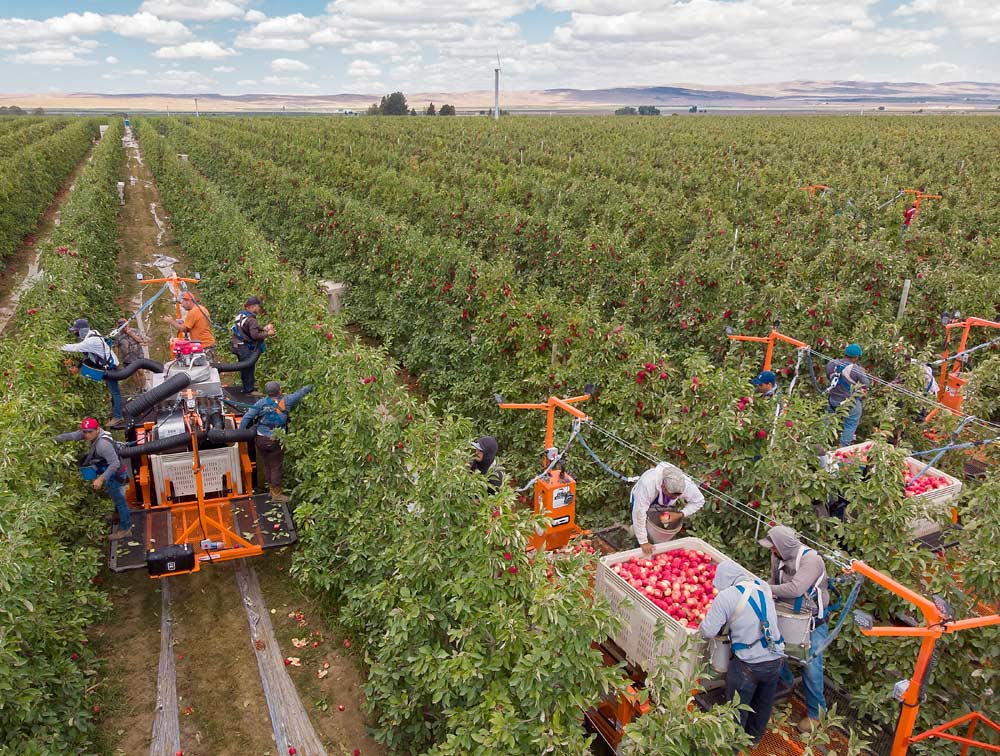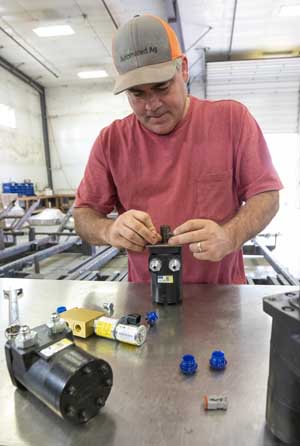
With four vacuum arms, a spinning bin filler and a noisy gasoline engine perched atop a self-steering platform, the Seussian machine earned itself a few nicknames as it motored through Central Washington orchards during trials this fall.
Transformer. Quadropus. Chupacabra.
Turns out, the contraption has a more literal moniker — Apple Vacuum System — but developers, orchard managers and even some workers seemed pleased by its performance, whatever it’s called.
“Everybody was pretty happy with the result,” said Bernardo Reyes, orchard manager for Stemilt Growers’ Quincy, Washington, orchard, one of the testing grounds for the platform-mounted vacuum system designed to eliminate bags and, therefore, bag emptying.
Pickers wear buckets attached to hoses connected to the vacuum. Each apple they place in a bucket is sucked individually through a padded tube and into a rotating dispenser that deposits the fruit evenly around the bin.
The mechanism aims to offer growers a harvest assist tool that falls somewhere between the use of platforms alone and the robotics of the future — along the lines of two European models that have conveyors on which workers place fruit.
East-West partnership
The machine represents a partnership of farmers and equipment manufacturers from Washington and Michigan.
The Apple Vacuum System itself was developed by DBR Conveyor Concepts of Conklin, Michigan, a partnership of grower Mike Rasch, welder and manufacturer Phil Brown, and Chuck Dietrich, a technician with a background in vacuum equipment from his oil and gas industry days.
The partnership had sold a few of the systems, mounted on Brown’s Brownie Quad platform, to customers in the Midwest, but approached JJ Dagorret, owner of Automated Ag Systems in Moses Lake, Washington, in the spring to explore the idea of mounting one to his Bandit Xpress, the most popular platform in the Northwest fruit industry.
Dagorret has a reputation for keeping equipment simple with interchangeable parts, Rasch said. Also, the Bandit Xpress fits the orchard spacing of the West Coast better than the Brownie. “That’s where this pairing made so much sense,” Rasch said.
The team hopes to sell it commercially in time for the 2019 harvest, making it available for growers to install on platforms they already own.
Results so far
Through the fall, the partners tested it in several orchards in Central Washington. They admit they have more work to do, but they like what they see so far, and orchard managers seem to agree.
For one thing, it’s fast.
In August, the four partners, Reyes and a few onlookers huddled in the Quincy orchard for one of the first trials through the rows of Stemilt’s SweeTango crop. A crew of four strapped to the vacuum started at the same time as crews on Bandit Xpress platforms without the vacuum.
“It was a shotgun start on the end of this row, we were neck to neck then we pulled away from them,” Rasch said partway through the unofficial race. “So, currently, we’re, I don’t know, four Bandit lengths ahead of them, five. Looks like the wild card may take this one.”

In the end, the vacuum system proved twice as fast; its crew picked 18 bins in six hours, while the other crews on unaltered platforms picked only nine, Reyes said. The Quincy orchard already has 15 Bandit Xpress platforms.
It also led to less bruising than did hand pickers using platforms alone, which surprised Reyes. Packing reports showed the SweeTango apples, a bruise-sensitive variety, had 2 percentage points less bruising when harvested by workers using the vacuum system than when harvested by workers on platforms alone.
Workers seemed pleased, too, Reyes said. He let both experienced and inexperienced pickers try. Some of the veterans complained that the machine felt slower because they had to place one apple at a time in the bucket but came around when they saw the overall speed increase. And everybody, both expert and novice, increased their picking time in the end, he said.
Keith Veselka, ranch manager for Occidental Orchards in Zillah, also saw double the efficiency when he tried the vacuum system in a Fuji block. A crew of four averaged 15 minutes per bin while their counterparts on an unaltered platform averaged 30 minutes per bin. Both crews were new to platforms.

Bruising rates were about the same, according to pre-pack quality control reports, he said. His pickers told him they felt comfortable using the machine, though they had philosophical misgivings common to many technological advances.
“A couple of workers thought I was trying to replace them and I said, ‘No, I need you. I’m just trying to make you faster and less fatigued,’” he said.
Veselka has used platforms for a few years now for chores such as pruning, thinning and training. He had planned to try them this year for the first picking anyway. Then the vacuum system rolled through town, so he added it to his experiment.

Easier on workers
Stemilt’s Quincy workers told Reyes they felt less fatigue because they never carried any weight beyond just the bucket, and never needed to stop working to bend over and dump their fruit.
That’s Dagorret’s favorite part.
“I’m most happy now with the response from the guys that are working on it, the pickers themselves,” Dagorret said. “They like it because there’s no weight.”
Alfredo Niño, a picker for Domex Superfresh Growers, agreed after trying the machine in one of the company’s Royal City blocks. “Because I’m not carrying the bag it makes me less tired,” said the seasonal employee through a translator.
Andy Arnold, the orchard manager for Domex, was impressed by the machine’s level of automation, but packout results were inconclusive. The orchard had only ladder-picked bins with which to compare and a misadjusted bar on the vacuum system inflated the percentage of damaged fruit until Dagorret’s team fixed the problem.
Dagorret estimates each bin fits 25 bags and workers spend about 10 seconds to dump each bag when it’s full. By his math, just eliminating that one dumping motion would save just over four minutes per bin.
Dagorret hopes to modify the machine over the winter to improve the distribution of the fruit around the bin and somehow dampen the noise for the workers on the platform.
The partners have not announced a possible price for the new vacuum-platform combination or the details of their partnership, but plan to display their creation at the NW Hort Expo in Yakima, Washington, in December, held in conjunction with the annual Washington State Tree Fruit Association Annual Meeting. •
—by Ross Courtney
Related:
—Raising the platform bar






Leave A Comment